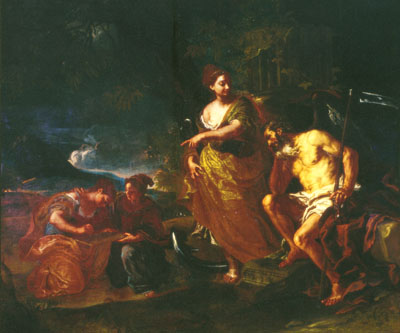
Barbara Kaiser’s discussion of Saturn is most engaging. She helpfully explicates the emblematic details of the Eggenberg allegory but also reveals the deep paradoxes in the lore of this god of finality. About the painting she says: Saturn, “his head supported by his right arm, appears as an old man with wings, an hourglass and a scythe before the backdrop of an ancient ruin in the darkness of night. At his side, the allegorical figure of Hope with an anchor in her arm points to two girls squatting on the ground. They are personifications of Perseverance and Patience, as they draw a circle with a compass.” Saturn is like and unlike the Greek Kronos. In Sentence of the Gods the corresponding figure is EL, who gathers into himself the eponymous Sumerian and Babylonian, Phoenician and Hebraic gods.
In the ancient world Kronos, says Kaiser, was treated with “a special reverence but also had a terrifying aspect. On the one hand Kronos-Saturn was a benign god of agriculture who taught people how to cultivate crops, build cities and mint coins and invented the system of measures and weights. At the same time he was a fierce and sinister deity who had lost the usurped throne of gods and now lived, exiled from the Earth, in the depths of Tartarus, the prisoner of his own children, whom he had devoured. Thus he later became also a god of death and the dead. The ruler of the Golden Age and the Island of the Blessed is also a demon, who demanded human sacrifice. Sophocles even identified him with Moloch.” His sickle is thus an ambiguous symbol: a tool for harvesting but also a weapon for castration.
MM’s EL, who presides over two optimistic books, Excelling (about China) and Life (the most various and compendious in the Sentence) bears little relation to most of this.